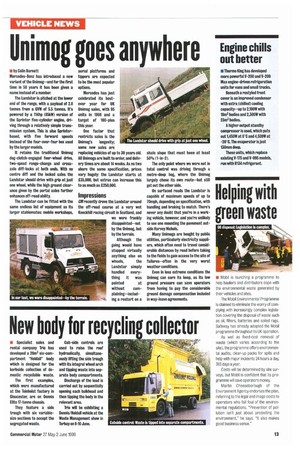Unimog goes anywhere
Page 15

If you've noticed an error in this article please click here to report it so we can fix it.
by Colin Barnett Mercedes-Benz has introduced a new variant of the Unimog—and for the first time in 50 years it has been given a name instead of a number.
The Landstar is pitched at the lower end of the range, with a payload of 2.8 tonnes from a OVW of 5.5 tonnes. It's powered by a 114hp (85kW) version of the Sprinter five-cylinder engine, driving through a relatively simple transmission system. This is also Sprinterbased, with five forward speeds instead of the four-over-four box used by the larger models.
It retains the traditional Unimog dog-clutch-engaged four-wheel drive, two-speed range-change and crossaxle dill-locks at both ends. With no centre dill and the locked axles the Landstar should drive with grip at just one wheel, while the high ground clearance given by the portal axles further enhances off-road ability.
The Landstar can be fitted with the same endless list of equipment as its larger stablemates: mobile workshops, aerial platforms and tippers are expected to be the most popular options.
Mercedes has just celebrated its bestever year for UK Unimog sales, with 95 units in 1998 and a target of 100-plus this year.
One factor that restricts sales is the Unimog's longevity: some new sales are replacing vehicles of up to 30 years old. All Unimogs are built to order, and delivery times are about 14 weeks. As no two share the same specification, prices vary hugely: the Landstar starts at 35,000, but extras can increase this to as much as £250,000.
Impressions CM recently drove the Landstar around the off-road course at a very wet Knockhill racing circuit in Scotland, and we were frankly disappointed—not by the Unimog, but by the terrain.
Although the going would have stopped virtually anything else on wheels, the Landstar simply handled everything it was pointed at without com plaining—including a restart on a shale slope that must been at least 50% (1-in-2).
The only point where we were not in total control was driving through a metre-deep bog, where the Unimog largely chose its own route—but still got out the other side.
On surfaced roads the Landstar is capable of maximum speeds of up to 70mph, depending on specification, with handling and braking to match. There's never any doubt that you're in a working vehicle, however, and you're unlikely to see one mounting the pavement outside Harvey Nichols.
Many Unimogs are bought by public utilities, particularly electricity suppliers, which often need to travel considerable distances by road before taking to the fields to gain access to the site of failures—often in the very worst weather conditions.
Even in less extreme conditions the Unimog can earn its keep, as its low ground pressure can save operators from having to pay the considerable ground damage compensation included in way-leave agreements.
























































































































